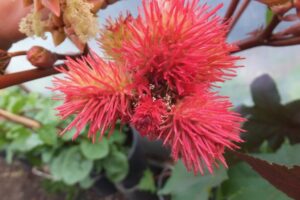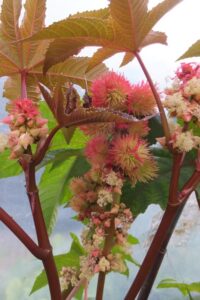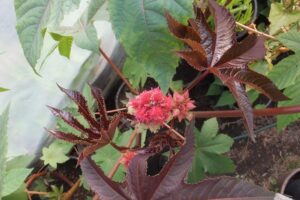
Many greenhouse plants are poisonous so one always needs be vigilant if children visit. And particularly with seeds of the pretty Castor Oil plant, Ricinus communis, from the Euphorbia family. Though the foliage and flowers are poisonous these seeds are extremely toxic. Once known as Palma Christi the seeds have been found in Egyptian tombs, the oil extracted from the seeds was burnt in Roman lamps. This oil was also used as a laxative, for thousands of years, apparently safely if unpleasant -as long as well purified. (Castor oil was also used for lubricating early engines with such as the famous brand Castrol.)

All that said these are also amongst the most impressive, large, fast growing, annuals for both decorative foliage, magnificent flowers and architectural seed pods. We grow this as an annual when it may make a couple of metres or so tall though in hotter climes it becomes a short lived tree up to twelve or thirteen metres! Confined in a tub one remains compact and conveniently then produces the flowering display at a more viewable level, and without pushing your greenhouse roof off. In summer plants can be moved onto the patio or planted out though the display remains far better longer when kept under cover away from the weather.

Although named varieties are propagated from cuttings seed is quick and easy. Sow in warmth from early in the year and grow on under cover much as with tomatoes increasing pot size to small tubs as the plants mature. They enjoy rich moist compost and regular feeding but are otherwise remarkably problem free, few pests try nibbling this more than once…

The foliage is handsome, usually dark green though many varieties have vinous red or other colouration which adds immensely to their appeal. This foliage is heavy so stems often benefit from a stout cane as support, earthenware tubs are also sensible counterbalancing the weight. The flowering heads appear early going on for ages continually looking fantastic as they mature becoming even more decorative as spiky seed pods (which can be dried for flower arrangements). At the end of the year collect and compost or bury dying plants and all fallen material for safety (though of course collect a few seeds for starting again the following spring and / or over-winter cuttings). The enthusiast will find more than a half dozen varieties which have been bred for even more impact -though initially the species is well impressive enough anyway.


